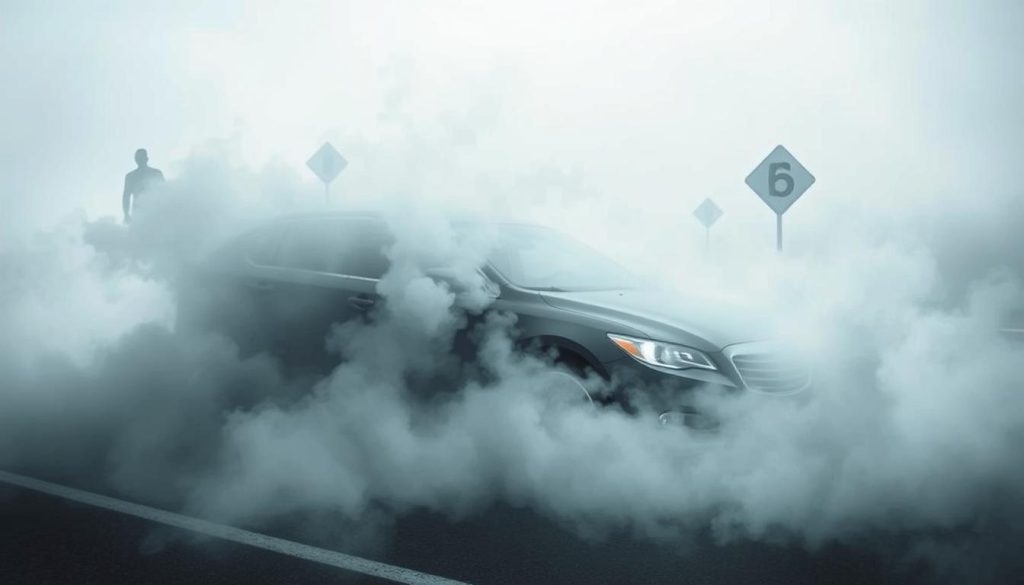anxietywhendriving.com highly recommends The Driving Fear Program to overcome your Driving Anxiety 90 Days Money Back Guarantee!
-->Click Here<--

Did you know 8 million Americans have driving phobia, also known as vehophobia? This fear can make it hard to live independently. Driving is key for many in the U.S. But, there’s hope. Cognitive-behavioral therapy (CBT) is a top choice for beating driving fear.
In this detailed article, we’ll look at why people fear driving, its signs, and how CBT can help. You’ll learn how to face your fears and feel free on the road again. By understanding your fear and using proven strategies, you can regain your confidence and independence.
Key Takeaways
- Driving phobia, or vehophobia, is a persistent and intense fear of driving that can severely limit daily life.
- Cognitive-behavioral therapy (CBT) is a highly effective treatment for overcoming driving phobia.
- CBT techniques, such as exposure therapy and cognitive restructuring, can help you manage anxiety and reclaim your confidence on the road.
- Understanding the root causes of your driving phobia, such as traumatic experiences or obsessive-compulsive tendencies, can aid in the recovery process.
- Implementing strategies to overcome avoidance behaviors and gradually face your fears through in vivo exposure can lead to lasting improvements.
Understanding Driving Phobia (Vehophobia)
Vehophobia, or driving phobia, is a specific phobia. It makes people intensely afraid of driving or riding in a vehicle. This fear can greatly affect daily life, making simple tasks like commuting to work hard.
What is Driving Phobia?
Driving phobia is an anxiety disorder. It causes an irrational fear of being in a car or driving. People with this phobia may feel symptoms like sweating, trembling, and rapid breathing. They also worry about driving dangers, like accidents or losing control.
Symptoms of Driving Phobia
The symptoms of driving phobia are both physical and psychological. Common symptoms include:
- Intense fear or anxiety when driving or even thinking about driving
- Avoidance of driving or situations that require driving
- Panic attacks while behind the wheel
- Muscle tension, rapid heartbeat, and sweating when driving
- Intrusive thoughts about the potential dangers of driving
- Difficulty concentrating on the task of driving
These symptoms can make daily life very hard. They can lead to isolation, social withdrawal, and a lower quality of life.
Causes of Driving Phobia
Driving phobia, also known as vehophobia, has many causes. Two main factors are traumatic experiences and obsessive-compulsive disorder (OCD).
Traumatic Experiences and PTSD
One big reason for driving phobia is post-traumatic stress disorder (PTSD) after a scary event. This could be a car accident, a close call, or seeing a crash. These experiences can make driving very scary and cause a lot of anxiety.
The brain might link driving to the scary event. This can make people avoid driving and feel really scared when they do.
Obsessive-Compulsive Disorder (OCD)
Obsessive-compulsive disorder (OCD) also plays a role in driving phobia. A specific type, “hit-and-run OCD,” makes people worry they might have hit someone without knowing it. They might feel the need to keep checking for any signs of an accident.
This fear and need to check can make it hard for them to drive without feeling anxious or scared.
| Cause | Description |
|---|---|
| Traumatic Experiences | Car accidents, near-misses, or witnessing collisions can lead to the development of PTSD and a driving phobia. |
| Obsessive-Compulsive Disorder (OCD) | The “hit-and-run OCD” subtype can cause intrusive thoughts and compulsions related to the fear of having accidentally hit someone while driving. |
“Driving phobia is often rooted in traumatic experiences or OCD-related fears, making it a complex and challenging condition to overcome.”
Cognitive Behavioral Therapy for Driving Phobia
Cognitive-behavioral therapy (CBT) is a top choice for treating Cognitive Behavioral Therapy. It focuses on exposure therapy, where people face their fears in a safe space. This can be real-life driving or Virtual Reality Exposure Therapy (VRET) for those who find it hard.
Exposure Therapy and Virtual Reality
In exposure therapy, people with driving phobia face their fears step by step. They might drive on highways or cross bridges. This helps them get over their anxiety and fear.
Virtual Reality Exposure Therapy (VRET) is also helpful. It lets people try driving scenarios in a safe space. This is great for those who can’t face their fears in real life.
“VRET has been shown to be an effective treatment for driving phobia, helping individuals confront and overcome their fears in a safe and controlled setting.”
By using Cognitive Behavioral Therapy, exposure therapy, and Virtual Reality Exposure Therapy (VRET), people can beat their driving phobia. They gain the skills and confidence to drive freely again.

Overcoming Specific Driving Fears
Driving phobia can make certain situations very scary. Freeways, highways, bridges, and tunnels are often feared. These places are tough because of the speed, lack of control, and the risk of accidents.
Conquering the Fear of Freeways, Highways, Bridges, and Tunnels
Exposure therapy is a big help in fighting these fears. It slowly gets you used to scary driving spots in a safe way. This is part of cognitive-behavioral therapy (CBT).
- Start small: Begin with easier roads before moving to freeways and highways.
- Try virtual reality: It lets you face driving challenges in a safe space.
- Learn to cope: Use deep breathing and mindfulness to handle fear.
- Get help: Work with a therapist who knows about driving phobia.
By facing these fears and learning to cope, you can beat driving phobia. You’ll feel more confident on freeways, highways, bridges, and tunnels.
| Driving Situation | Common Fears | Exposure Therapy Approach |
|---|---|---|
| Freeways and Highways | High speeds, loss of control, risk of accidents | Start with smaller roads, gradually increase speed and distance |
| Bridges | Heights, feeling trapped, concerns about structural integrity | Begin with shorter bridges, practice crossing with a trusted companion |
| Tunnels | Claustrophobia, fear of being trapped, poor visibility | Exposure to shorter tunnels, work up to longer and more complex tunnels |
Be patient and kind to yourself when facing driving fears. With the right help and strategies, you can enjoy driving again. You’ll feel free and confident on the road.
“Overcoming driving phobia is not just about conquering the fear, it’s about reclaiming your independence and the joy of the open road.”
Panic Attacks While Driving
Having a panic attack while driving is scary and overwhelming. It’s key to recognize the attack, stay calm, and use good techniques to handle the symptoms. One helpful method is paced breathing. It can slow your heart rate and lessen panic feelings.
Don’t stop driving right away. Instead, aim to reach a safe spot like a parking lot. Stopping suddenly can make things worse. Keep calm and focus on driving to get through the attack.
Panic attacks are short-lived and will end. Using anxiety management like paced breathing and therapy can help. These tools can help you deal with driving anxiety and overcome your fear.
“The key is to remain calm and trust that the panic attack will pass. Panicking about the panic attack only makes it worse.”
Knowing what a panic attack feels like and using anxiety management techniques can help. Gradually facing driving situations can also help you feel more confident and free on the road.
Identifying and Overcoming Avoidance Habits
Driving phobia, also known as vehophobia, makes people avoid driving. They might steer clear of certain roads or hold onto the car door tightly. These actions help them cope but also keep the fear alive.
Spotting these habits is key in Cognitive Behavioral Therapy (CBT) for driving phobia. Knowing what behaviors cause the problem helps people face their fears. This way, they can feel more confident while driving.
Setting Mobility Goals
Setting mobility goals is vital in CBT. Goals might include driving longer distances or facing specific fears. Having clear goals helps people see their progress and stay motivated.
Recognizing Anxiety-Provoking Situations
- Driving on freeways or highways
- Navigating bridges, tunnels, or overpasses
- Merging into traffic or changing lanes
- Driving during peak hours or in heavy traffic
- Encountering inclement weather conditions
Knowing what triggers the driving phobia is another important step. By identifying these triggers, people can prepare to face them. This helps lessen the phobia’s effect on their lives.
“The only way to overcome your fear is to face it head-on, with the support and guidance of a qualified mental health professional.” – Dr. Sarah Williamson, Clinical Psychologist

By tackling avoidance habits, setting goals, and facing fears, people with driving phobia can start to feel free again. They can regain their independence on the road.
Implementing In Vivo Exposure
In vivo exposure is a key part of cognitive-behavioral therapy (CBT) for driving phobia. It involves facing the feared driving situations gradually. This naturalistic exposure helps reduce fear as one gets used to driving and finds out the feared outcome doesn’t happen.
Purposes of Naturalistic Exposure
Naturalistic exposure, or in vivo exposure, has several important roles in beating driving phobia:
- It lets people face their fears in real driving situations, not just in therapy.
- It teaches that the feared outcomes, like panic attacks or accidents, don’t happen.
- It helps people feel less anxious and more confident while driving.
Obstacles to In Vivo Exposure
Even though in vivo exposure works well, there are challenges to face:
- Trying to fit it into daily tasks like commuting or running errands might not be enough.
- Feeling too scared to face driving fears can lead to avoiding or stopping the exercises early.
- Finding quiet places to practice driving, like empty parking lots, can be hard.
To overcome these hurdles, working with a mental health expert is key. They can help create a gradual exposure plan that fits the person’s needs and comfort level.
“Naturalistic exposure is a powerful tool in overcoming driving phobia, but it requires careful planning and support to ensure success.”
Cognitive Restructuring for Driving Phobia
Cognitive restructuring is key in treating driving phobia, also known as vehophobia. It helps people face their fears by changing negative thoughts. This method is part of cognitive-behavioral therapy (CBT).
Those with driving phobia often think the worst about driving. They might believe they’ll cause a huge accident or something bad will happen. A therapist helps them see these thoughts as not true.
This process helps people see driving as less scary. As they change their thoughts, their fear and anxiety lessen. This makes it easier to face their driving phobia.
CBT for driving phobia uses cognitive restructuring along with other methods. These include exposure therapy and relaxation exercises. This mix helps people overcome their fears.
“The goal of cognitive restructuring is to replace irrational beliefs with more realistic and adaptive thoughts, which can significantly reduce the intensity of driving-related anxiety and fear.”
By changing their negative thoughts, people with driving phobia can feel more confident. They can learn to drive safely and effectively again.
Relaxation Techniques for Driving Anxiety
Using relaxation techniques can help those with driving phobia. Methods like deep breathing exercises, progressive muscle relaxation, and mindfulness-based practices can ease anxiety and panic while driving. These techniques target the physical signs of anxiety and panic that come up when driving.
Deep breathing exercises are great for fighting driving anxiety. By slowing down and deepening your breath, you can calm your body’s stress response. This helps you feel more relaxed, whether you’re getting ready to drive or already on the road.
Progressive muscle relaxation is another useful method. It involves tensing and then relaxing different muscle groups. This helps release physical tension and promotes relaxation. It’s especially good for those who feel tightness in their chest or muscles while driving.
Mindfulness-based practices, like meditation, can also help. They help manage the thoughts and feelings that come with driving anxiety. By being present and non-judgmental, you can face driving triggers with calmness, not fear.
Adding these relaxation techniques to a treatment plan for driving phobia can give people more control and confidence. It helps them manage their anxiety better and feel more at ease behind the wheel.
Systematic Desensitization for Driving Fears
Overcoming driving phobias can seem tough, but systematic desensitization is a proven way to face your fears. This method slowly introduces you to tough driving situations. It helps you manage your anxiety and fear.
The method works because it’s slow and steady. You begin with easy driving images, then move to simulated and real-life driving. You learn to relax while driving, gaining confidence and strength.
By combining exposure therapy with ways to manage anxiety, you can change how your brain reacts to driving. This approach has helped many people beat their driving phobia and anxiety management issues.
“Systematic desensitization is a powerful tool that can help you regain control and freedom on the road. With patience and dedication, you can overcome your driving fears and enjoy the journey ahead.”
Remember, beating driving phobia is a journey, not just a goal. By going through gradual exposure and anxiety management, you can change how your brain reacts to driving. This way, you can regain your confidence and independence while driving.
Conclusion
Cognitive-behavioral therapy (CBT) is a powerful tool for beating driving phobia, or vehophobia. It uses methods like exposure therapy and systematic desensitization. These help people face their fears and manage anxiety.
CBT tackles the root causes of driving phobia, like past traumas or obsessive-compulsive disorder (OCD). It teaches people to challenge their scary thoughts. They learn to slowly face driving situations that make them anxious.
This approach doesn’t just help with driving fears. It also prepares people for panic attacks while driving. Overcoming driving phobia with CBT is a tough but rewarding journey.
It leads to more freedom and confidence. With the right support and effort, people can drive without fear or anxiety holding them back.
FAQ
What is driving phobia (vehophobia)?
Driving phobia, or vehophobia, is a fear of driving or riding in a vehicle. It makes everyday life hard because driving is common. Many people in the U.S. need to drive daily.
What are the symptoms of driving phobia?
People with driving phobia might sweat, tremble, and breathe fast. They worry about accidents or losing control. These worries can cause a lot of anxiety.
What are the common causes of driving phobia?
Traumatic events, like car accidents, can cause driving phobia. Obsessive-compulsive disorder (OCD), especially “hit-and-run OCD,” also plays a role.
How can cognitive-behavioral therapy (CBT) help with driving phobia?
CBT is very effective for driving phobia. It includes exposure therapy and cognitive restructuring. Exposure helps face feared situations. Cognitive restructuring changes negative thoughts about driving.
What are some of the most feared driving situations for individuals with driving phobia?
Freeways, highways, bridges, and tunnels are often feared. These places can make people anxious because of the speed and perceived danger.
How can individuals manage panic attacks while driving?
If you have a panic attack while driving, acknowledge it. Use deep breathing to calm down. Try to drive to a safe place without panicking.
What are some common avoidance habits and safety compulsions in driving phobia?
People with driving phobia might avoid certain routes or hold onto the door handles. These habits are part of CBT to overcome.
What are the benefits of in vivo exposure therapy for driving phobia?
In vivo exposure therapy is a key part of CBT. It helps reduce fear by facing real-life driving situations. However, fitting it into daily life can be hard.
How does cognitive restructuring help in overcoming driving phobia?
Cognitive restructuring changes negative thoughts about driving. It helps reduce anxiety and fear. This way, people see driving as less dangerous.
What are some relaxation techniques that can help with driving anxiety?
Relaxation techniques like deep breathing and progressive muscle relaxation can help. They manage anxiety symptoms while driving or thinking about driving.
How does systematic desensitization work for driving phobia?
Systematic desensitization gradually exposes you to driving situations. It starts with easy ones and moves to harder ones. Relaxation techniques help manage anxiety during exposure.
anxietywhendriving.com highly recommends The Driving Fear Program to overcome your Driving Anxiety. 90 Days Money Back Guarantee!
-->Click Here<--



